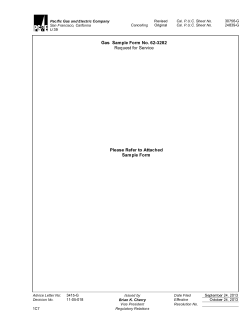
Document 342693
SCALE-UP OF REFRIGERATING APPLIANCE REBATE AND EXCHANGE SCHEME TO IMPROVE ENERGY EFFICIENCY CONTACT Kofi Agyarko Energy Commission Kofi.agyarko@energycom.gh www.energycom.gh 00233-27705242 Fredua Agyeman Ministry of Environment, Science, Technology and Innovation info@mest.gov.gh http://www.mesti.gov.gh 00233-302-666049 Yaw K. Oppong-Boadi UNFCCC CC Focal Point Environmental Protection Agency koppongboadi@gmail.com 00233-208186958 Inefficient household refrigerating appliances has been identified as a major contributor to wasteful use of energy in many homes (2006 study). Refrigerating appliances consume an average of 1,140 kWh/year in Ghana or approximately three times more energy consumption than is expected given recent trends in technology improvements. It also contribute to about 50% of household electricity bills in most Ghanaian homes. It is estimated that out of a total population of 2 million refrigerating appliances in use, over 70% are inefficient. The opportunity is to reduce the demand on the national grid with the transformation of the market from inefficient appliances to new efficient ones. There is also the lack absence of incentives for proper recycling of end-of-life appliances with e-waste challenges. The refrigeration market transformation NAMAs would target the fraction of inefficient fridges in Ghana estimated to be 1.4 million. The goal is to scale up the refrigerating appliance replacement and rebate scheme which provides an opportunity for more energy efficient use of household appliances. This is to promote the penetration of efficient refrigerating appliances (60,000) and enhances proper e-waste recycling by providing technical assistance and access to competitive credit facilities to retailers and recycling companies (4) and; financial incentives (rebates) to fund the discounts provided for the purchase of energy efficient refrigerating appliances and provide access of the appliances to recycling companies. GHG Implementing agency Implementation Timeframe Estimated Cost of Implementation Estimated emission reduction NAMA GHANA CO2, CFC Energy Commission, Ghana 5 Years. Estimated start Year 2015 and end year 2020 EUR 10,000,000 155,520 tCO2eq; 146,400tCO2eq from CFCs The refrigerating market transformation NAMA seek to reduce GHG emissions by replacing grossly inefficient fridges with new ones using a rebate scheme. Co-benefits + local sustainable The project would contribute to sustainable development co-benefits in the following aredevelopment as: Increased access to electricity when savings made in the project are freed up for additional households. directly fund rebates to users from poorer homes unable to afford market prices of brand new fridge. Improvement in environment and health quality. Positive contribution to employment Improved power distribution and reduction of blackouts Reduction in electricity household demands and expenditure Recycling, retailing centres and assembling plants established – (Job creation), (increased incomes)-huge potential to transform recycling processes Technology transfer (refrigerator test facility , dismantling facility, and efficient refrigerators) Refrigeration market transformation (appliance labelling and import ban of used appliances) e-waste management Phasing out of CFC Health benefits (scavengers) Prevention of environmental pollution Links to national policies, plans National Energy policy; National Climate Change Policy and strategies MRV plan A project Steering committee will ensure a plan to document and cover: Emissions Avoided Activity Coverage Energy reduction Project improvement Number new fridges sold at retail centres under rebate scheme. Quantity of ODS recovered. Total amount expenditure on turn in appliance. Number of inefficient fridge collected (no) at recycling centres HH demand/consumption before/after (kwh) , Import of new fridges vrs used ones (quantity of imports) In the national energy policy, emphasis is given to three priority areas: increases access to affordable energy, improving energy efficiency (NAMA project alignment) and doubling access to renewable energy.
© Copyright 2025



















